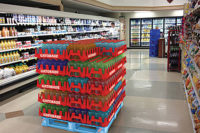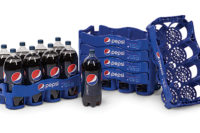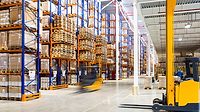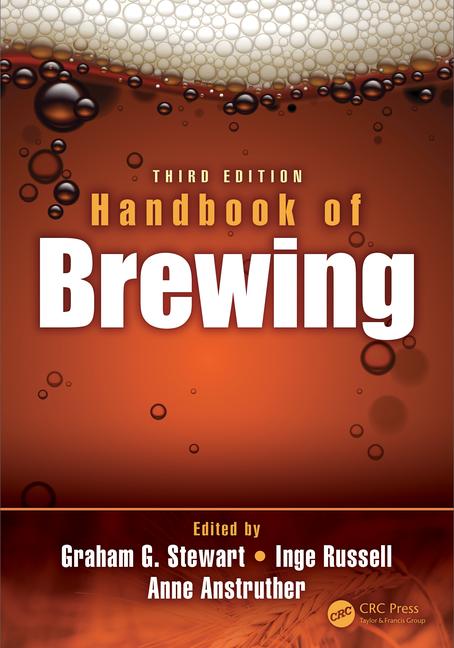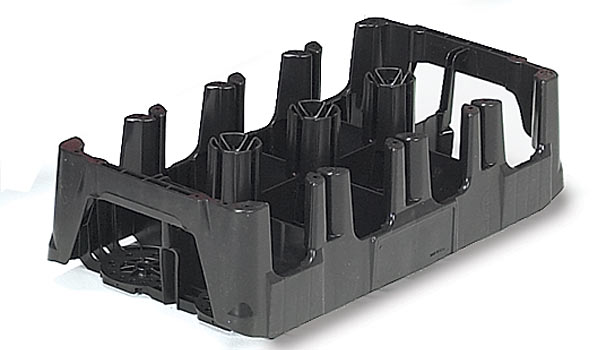Reusable containers offer multi-use functionality
Cost, merchandising and sustainability traits appeal to beverage-makers








The case for reusable containers is getting stronger. The ability of beverage-makers to ship products in reusable cartons — some of which also function as in-store displays — is resulting in potentially powerful cost savings while also giving companies an environmentally friendly aura.
Although not for everyone — particularly operators who infrequently ship lower volumes — reusable containers are becoming increasingly attractive. In addition to the cost savings from reusing containers instead of shipping products in single-use corrugated boxes, reusable designs also can serve as vibrant marketing tools. And, by attaching tracking and communications tags, users can minimize lost and stolen items while also supporting consumer promotions.
Indeed, in a 2014 pilot program in Burnsville, Minn., for promoting 2-liter beverages from Purchase, N.Y.-based PepsiCo Inc., bottles were displayed in custom shells from Rehrig Pacific Co., explains Brian Lindell, vice president of beverage for the Los Angeles-based company. The shells, featuring the Pepsi moniker and colors, also contained technologies that enabled smartphone users to tap the displays and receive coupons for $5 off a day game ticket to the National Collegiate Hockey Conference 2014 Frozen FaceOff tournament. The containers were affixed with 2-D quick-response barcodes and supported with near-field communication (NFC).
“Enabling the reusable containers to digitally engage with consumers makes them more than just a piece of dunnage,” Lindell says. “The designs with the bright logos of products also make them attractive to consumers.”
Also becoming more prevalent are tracking technologies, which, in addition to helping pinpoint lost and stolen containers, can enable beverage-makers to learn how often containers are utilized, leading to greater cost efficiencies.
“When launching a new product or SKUs, it is critical to know the amount of containers that are needed,” Lindell says. “Companies that overbuy have assets sitting idle and tying up cash flow. If they buy too little, there won’t be enough containers to support the given level of sales. It is eye opening for users to understand the turn rate, and that can be accomplished by putting tags on containers.”
Lost and found
But finding missing containers is perhaps the greatest advantage. “Reusable containers are a great option because of the return on investment (ROI) and environmental issues,” says Kevin Marrie, director of sales for The Kennedy Group, a Willoughby, Ohio-based provider of identification tools. “But companies have to be sure that they get them back, so it’s important to have tracking pieces.”
A white paper commissioned by Rehrig Pacific, for instance, reports that the dairy industry loses an estimated 20 million stolen milk crates each year. With a replacement expense of about $4 each, it costs the sector more than $80 million annually, with an environmental impact equivalent to 1.34 billion plastic water bottles, according to the white paper.
The Kennedy Group’s Marrie says the annual attrition rate for returnable containers that have been lost or stolen typically is 15-30 percent. Using technologies to track missing containers not only can save companies large replacement costs but also reduces the time employees must spend searching for the items.
Among the tracking options are barcodes, which cost between $0.05 and $0.10 each in volume and are scanned individually. Readers typically range from $200 to $800 each. For easier access, barcodes should be placed on each side of a container, Marrie advises.
Radio-frequency identification (RFID), meanwhile, uses electromagnetic fields to transfer data. RFID tracking typically is quicker, as containers with the chips only need to be in proximity of readers, and large volumes of containers can be scanned in unison.
Indeed, Marrie notes that pallets with RFID containers can be driven through a portal scanner at a dock door, which reads all the tags on all of the trays instantaneously. This eliminates the labor costs of scanning each container individually and inaccuracy issues from human error, he says.
Unlike barcodes, RFID tags can be reprogrammed and typically cost from $0.20 to $0.30 each when purchased in volume. Portal readers often range from $2,500 to $4,000, and a handheld reader can be $3,500. Companies also need to invest in middleware or software to gather data and report the information. Licenses often range from $10,000 to $100,000. Companies have been slow to leverage RFID systems based on these higher costs, Marrie says.
And tracking systems are proving to be effective. In a 2013 RFID test at seven plants in the Southeast, PepsiCo — using 20,000 shells from Rehrig Pacific — cut losses by 25 percent, Rehrig Pacific’s Lindell reports.
Mixing and matching
In addition to leveraging optimal technologies, it also is crucial that beverage-makers have reusable containers that can support the growing array of bottles and cans with unique sizes and shapes.
Helping to trigger such added beverage selections is the launch of health-oriented products along with an explosion in craft breweries that offer unique flavors, says Bob Klimko, director of marketing for food and beverage for Orbis Corp., Oconomowoc, Wis.
“More choices mean different types of packaging are often required, and companies have to change their reusable containers to accommodate them,” he states. “These industry trends and changes are putting pressure on distribution supply chains that traditionally offered few SKUs and now must ship hundreds of SKUs in often smaller lot sizes.”
Christof Weis, manager of business development for Europe for IFCO Systems, Tampa, Fla., concurs, noting that an increase in the range of beverage bottle sizes is making it challenging for packers to access reusable containers that can support all SKUs. In response, IFCO is marketing containers and trays that can hold multiple types of bottles, including different package sizes of varying brands, such as six-packs of a standard beer and eight-packs of a light beer. Such containers also are often used as displays that are situated in front of retail aisles.
A returnable route
In addition to investing in containers, beverage-makers and distributors need to determine the optimal systems for transporting containers from plants and warehouses to retail locations and then getting the empty containers back to the original source, experts note.
“Companies also need to contemplate what it will take to manage a system,” IFCO’s Weis says. “That includes capital expenditures and personnel and administrative resources. “
Beverage-makers can outsource operations to third parties, such as IFCO, which supply the containers and trays and operate the system for delivering and returning containers. IFCO touts its containers as being easy to assemble and disassemble while requiring no staples, wires or sharp edges and featuring an ergonomic design that reduces strains and pulls from heavy lifting. IFCO also offers a variety of containers and trays that support varying bottle types, including glass and PET items, and some trays have double-sided usage, with one side for multipacks and the other for single bottles. IFCO’s Weis adds that the sturdiness of such reusable containers results in lower damage rates compared with products packed in cardboard.
Dan Huhn, new product development manager for Buckhorn Inc., Milford, Ohio, adds that although a larger upfront cost is required for the reusable options compared with corrugated boxes, users often see an ROI within several years. Reusable containers, however, typically are not optimal for companies that deal with smaller inventories that are sent infrequently.
“They make the most sense for companies that ship the same amount of containers on a regular basis because of the constant activity,” notes Joe Borer, Buckhorn market manager. He adds that reusable containers can be stacked higher than corrugated boxes, allowing users to increase their inventory in the same amount of space.
Buckhorn’s newest product, Intrepid, is a 48-inch by 40-inch container that is intended to eliminate the issues associated with corrugated options, including leakage, shifting off the pallet during transport, debris and dust, and limited one-time use. Borer adds that it also can be more efficient and cost effective in some instances for companies to have a third party own the containers — which are then leased to users — and operate a logistics system to pick up, clean and repair the empty containers before transporting the items back to the beverage-maker. Users also can pay for the containers based on each trip use.
“We will see more of that occurring, because many companies will say, ‘We’re in the food and beverage industry and not on the logistics side,’” Huhn says. “It eliminates the upfront capital expenditures of converting to reusable containers. But there also has to be the cost justification for it to make sense.”
Buckhorn also supports companies leveraging reusable containers by providing training videos that cover such elements as container handling by forklift drivers, loading containers on trucks and repairing containers.
In addition, the company offers a recycling program in which it buys back used containers, provides a repair service, develops ROI schedules, and reviews damaged containers to pinpoint the cause of incidents.
Rehrig Pacific’s Lindell, meanwhile, notes that containers can last 15 years if they are not lost or encounter damage. “They also are a great remedy for creating sustainability in the supply chain, as reusable packaging is better for the environment with fewer greenhouse gas emissions,” he says.
A sustainable solution
A study commissioned by Rehrig Pacific comparing reusable plastic crates with corrugated trays with film found that the plastic crates require 46 percent less total energy, produce 89 percent less total solid waste, and generate 65 percent less total global warming potential. Plastic crates also generate the equivalent of 244 pounds of carbon dioxide equivalent, compared with 705 pounds for corrugated trays with film. The study compared 1,000 cases of 20-ounce bottles using the different returnable container packaging.
Orbis’ Klimko notes that his company’s packaging engineers often make recommendations for container selection after reviewing such elements like how far a beverage-maker’s products are being shipped and how long the containers are expected to last. “There are methodologies to compare solutions based on carbon, energy and solid waste, but there is no one panacea,” he says.
The ability to cut operating expenses, become more environmentally responsible and enhance marketing makes reusable containers an appealing option. With added technologies helping to reduce the number of missing containers, the business case keeps getting stronger.
Looking for a reprint of this article?
From high-res PDFs to custom plaques, order your copy today!



